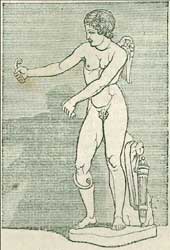Amor

The god of love and harmony. He had no place in the religion of the Romans, who know and speak of him only from what they had heard from the Greeks, and translate the Greek name Eros into Amor. Various gods are named as his parents, but most commonly Venus.

In Virgil's Aeneid, Amor plays an important role in the romance between Aeneas and Dido.
❧
Iconography
In antiquity Amor is portrayed as a youth, with and without wings, armed with bow and arrows. As such he is depicted by the sculptors Praxiteles, Scopas, and Lysippis (fourth century BCE), and several centuries later as Amor and Psyche. In Hellenic art he is a small youth. The amoretto, also amorini and putti, play an important role in Hellenic and Roman paintings, such as at the Casa dei Vettii (Pompeii). The fresco with the "punished Amor" in the Casa di Amore Punito (Pompeii) is well-known. In Renaissance and baroque art the small, playful amoretto are frequently used in paintings and illustrations, among which Boccaccio's "Decamerone."
References
Sources
- Aken, Dr. A.R.A. van. (1961). Elseviers Mythologische Encyclopedie. Amsterdam: Elsevier.
- Smith, William. (1870). Dictionary of Greek and Roman Biography and Mythology. London: Taylor, Walton, and Maberly.
- Virgil. Aeneid i, 658.
This article incorporates text from Dictionary of Greek and Roman Biography and Mythology (1870) by William Smith, which is in the public domain.